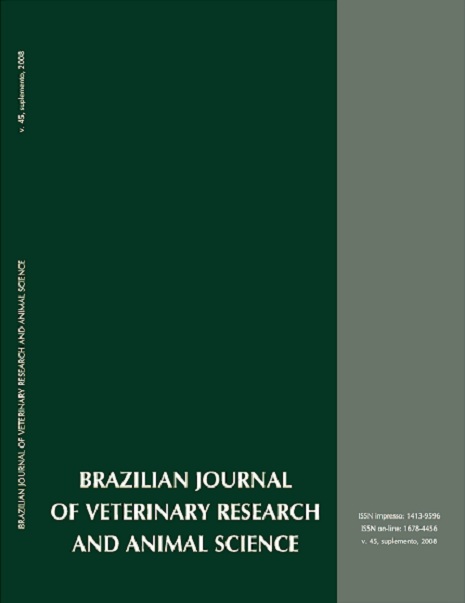In vitro efficiency of three extenders for rabbit semen
DOI:
https://doi.org/10.11606/S1413-95962008000700004Keywords:
Rabbit, Semen, Extender, Artificial inseminationAbstract
The objective of this experiment was to compare in vitro efficiency of three rabbit semen extenders: sodium lactate Ringer solution, sodium citrate and yolk-egg medium, and skim milk-based medium, on maintenance of sperm vigour and motility. To that end 5 rabbits were utilized; ten semen collections were taken from each (n = 50). The semen was collected by artificial vagina, and evaluated for volume, motility, vigour, and concentration. The semen was diluted (20x10(6) spermatozoa/mL) in pre-warmed micro tube at 37ºC in the three extenders, and then it was incubated in water bath at 37ºC during 120 minutes, performing evaluation every 30 minutes. Immediately after the dilution (time 0) the sperm motility was not different among extenders (P>;0.05), however, decreased (P<0.05) in Ringer extender when compared to in natura semen. The vigor in time 0 decreased (P<0.05) in the three extenders. The sperm motility was better preserved (P<0.05) during the incubation from 30 to 120 minutes for the semen diluted in yolk egg-citrate and skim milk-based extenders than for the Ringer extender. The vigour preservation varied among the extenders during the in vitro incubation; however, it was similar among the three extenders after 120 minutes of incubation. Based on these results, it can be deduced that the tested extenders promote a medium that allows the maintenance of sperm viability so that artificial insemination can take place within two hours of post-dilutionDownloads
Download data is not yet available.
Downloads
Published
2008-12-01
Issue
Section
UNDEFINIED
License
The journal content is authorized under the Creative Commons BY-NC-SA license (summary of the license: https://
How to Cite
1.
Andrade AFC de, Celeghini ECC, Yonezawa LA, Spers A, Arruda RP de. In vitro efficiency of three extenders for rabbit semen. Braz. J. Vet. Res. Anim. Sci. [Internet]. 2008 Dec. 1 [cited 2024 May 8];45(supl.):33-9. Available from: https://www.revistas.usp.br/bjvras/article/view/26726





